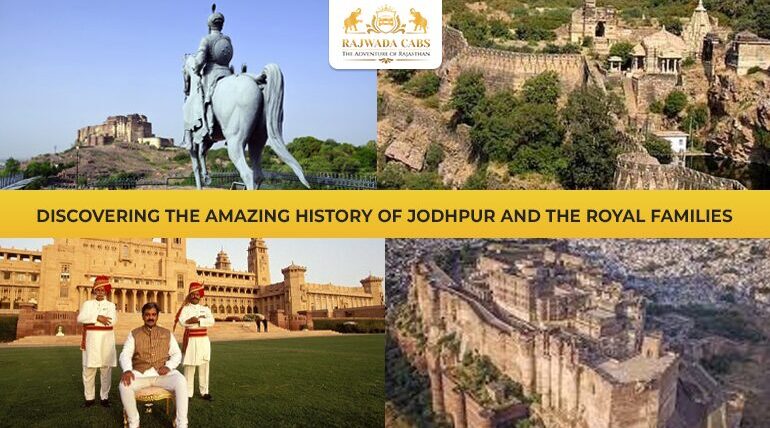
Introduction
India has many hidden stories and destinations that have yet to be discovered. There are even places that only a few people know. In this blog, read about the beautiful Blue City of India, Which is in Rajasthan, one of the most vulturous places you’ll find. Jodhpur has one of the largest forts in India, including dishes in Rajasthan place, filled with foodies, and for foodies, it has every kind of food you would like. While traveling to Jodhpur, don’t forget to get a travel partner for a more adventurous as well as peaceful trip; Jodhpur cab booking with Rajwada Cabs at Jodhpur as most tourist attractions Rajwada cabs are famous among them to travel around the city and explore different cities from the state as well. Historic stories and landmarks are things to look deeper into the destination to find beautiful stories and secrets behind the landmarks.
The Origins of Jodhpur and the Rathore Dynasty
Founded in 1459 by Rao Jodha of the Rathore Clan
The history of Jodhpur dates back to 1459 when Rao Jodha, the head of the Rathore family, founded it. This visionary ruler founded the city on the edge of the beautiful Thar Desert, located in the middle of the arid plains of Western Rajasthan. Jodhpur areas were before villages, but they added to the city from time to time as the citizens grew with it.
Served as the Capital of the Kingdom of Marwar
Throughout history, Jodhpur has been the capital of the Marwar Kingdom, a princely state ruled by powerful Rathores. The city flourished under their rule and became a center for trade, culture, and military expertise. One of the largest military centers in Jodhpur has grown and maintained its position over time, including the trade of spices, especially red chilies, one of the originals grown here.
Rathors ruled Jodhpur until India’s independence in 1947
Over the centuries, the Rathore dynasty profoundly impacted Jodhpur, changing its fortunes and leaving an indelible mark on the country. Their reign lasted until the dawn of Indian independence in 1947; It marked the end of an era filled with courage, beauty, and tradition.
Mehrangarh Fort – History and Significance
Built by Rao Jodha in 1459 on a Steep Hill
One of the crown jewels of Jodhpur’s architectural heritage is the magnificent Mehrangarh Fort, built atop a formidable hill in 1459 by Rao Jodha. The stones and craftsmanship are so unique and traditionally made to represent the culture and religions of Rajasthan. This mighty fort served as the seat of power for the Rathore rulers and symbolized their authority and respect.
Served as the seat of the Rathore rulers
Mehrangarh Fort was a defensive fortress with tall walls that saw several conflicts and conquests. Within its firm grasp are a plethora of palaces, temples, courtyards, and a museum, each telling a story of heroism and nobility.
Provides stunning views of the Blue City.
Perched magnificently on a steep hill, Mehrangarh Fort offers spectacular panoramic views of Jodhpur, nicknamed “Blue City.” Visitors may enjoy a stunning view of azure-hued roofs tumbling down the slopes from various vantage points.
Umaid Bhawan Palace – The Last Royal Residence
Built-in 1943 by Maharaja Umaid Singh
The renowned Umaid Bhawan Palace, a witness to the luxury and majesty of Jodhpur’s royal legacy, is a masterpiece of architecture. Maharaja Umaid Singh built this incredible palace in 1943 as the Jodhpur royals’ ultimate residence.
Currently, Partly a Museum and Partly a Hotel
Today, Umaid Bhawan Palace exemplifies grandeur and extravagance, with a phase of its full-size grounds transformed into a museum showing the region’s wealthy history and traditions. The different section serves as an international-magnificence motel, offering traffic with a royal revel surrounded by unsurpassed splendor.
Jaswant Thada – The Royal Crematorium
Jaswant Thada, a calm white marble monument created in 1899 by Maharaja Sardar Singh in Jodhpur, exemplifies the city’s rich legacy. It is built within green gardens and has finely carved memorials honoring Jodhpur’s monarchs and families. The monument represents the city’s aristocratic pedigree and rich past. The Royal Crematorium, situated on the outskirts of Jodhpur, has sweeping views of the Mehrangarh Fort and provides tourists with an atmosphere of peace.
Exploring the History with Rajwada Cabs
Rajwada Cabs provides traditional car tours of Jodhpur’s historic sites.
Rajwada Cabs provides a unique chance to see the city’s essential attractions in beauty. Their collection of historic automobiles takes visitors on a nostalgic voyage back in time, allowing them to experience the grandeur of the past.
Travel in classic cars to immerse yourself in the city’s royal heritage.
Walking through the city’s meandering streets and busy bazaars, you’ll be transported to a period of imperial magnificence and timeless grace. They provide taxi in Jodhpur so you can easily travel around the marketplaces and buy souvenirs and classical things.
Knowledgeable drivers provide stories and histories from each location.
Rajwada Cabs’ expert drivers will guide you every step of the way, and their love for Jodhpur’s heritage knows no boundaries. From Mehrangarh Fort to Jaswant Thada, each site is infused with colorful narratives and exciting information, creating a vivid picture of the city’s historic history.
Conclusion
To conclude this blog, try traveling to Jodhpur with an incredible view and knowledge of historical events in the landmark’s beauties. The regal legacy of Jodhpur demonstrates perseverance through the tradition of its respectable rulers, whose boldness and vision formed the fate of the Blue City. From the monumental defenses of Mehrangarh Post to the extravagant lobbies of Umaid Bhawan Castle, each edge of Jodhpur reverberates with the murmurs of history. Investigating this charming city with a taxi service in Jodhpur offers a brief look into a former period, where stories of courage and sentiment entwine amid the magnificence of Rajasthan’s glorious past.







